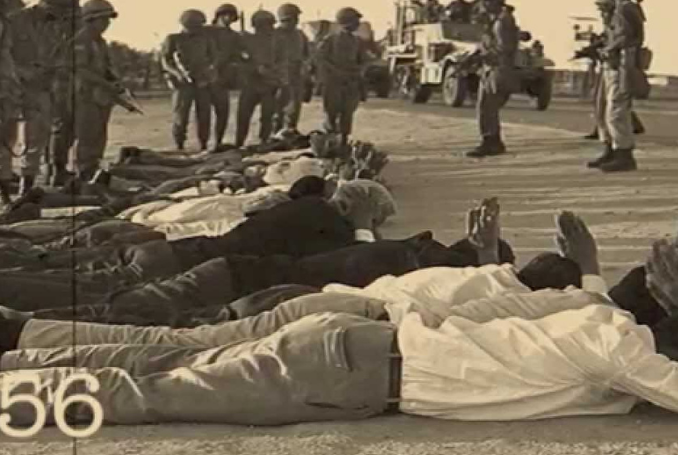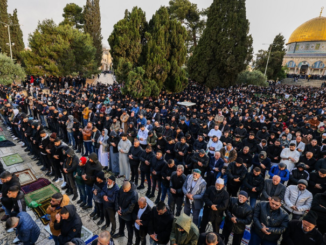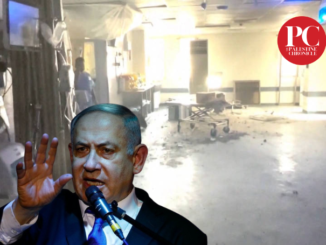
By Hebh Jamal
Palestinian memory holds years and dates close. The Nakba was in 1948, the Naksa in 1967, Sabra and Shatila September 1982, the Intifada ‘87. November 3, 1956, however, does not live in infamy. Despite being one of the greatest massacres of Palestinians, the Khan Yunis massacre that brutally took the lives of hundreds of Palestinian men and boys, has only received a footnote in history- a mere few lines in a UN report.
The massacre came against the backdrop of a war waged by Israel, Britain and France against Egypt. It was an effort to take over the Suez Canal after it was nationalized by Egyptian President Gamal Abdel Nasser.
Israeli leaders launched Operation Kadesh, the plan to conquer the Sinai before taking control of the Gaza Strip. Their central aim was to destroy the Palestinian armed resistance, the fedayeen, that were fighting under Egyptian command. They viewed a strike on the Egyptian regime as the optimal way to squander Palestinian resistance.
On November 2, the Egyptian forces virtually lost all control of the Sinai Peninsula. After a heavy bombing campaign on the town, Israeli infantry and tanks entered Khan Yunis the next day to “root out” the presence of the fedayeen.
Residents recall waking up to the loudspeakers of the occupation military vehicles, calling for all the young men ages 16 to fifty. The occupation forces were reported taking these men to public squares in a gruesome display of violence, shooting them all. Hundreds were killed on the first day of the massacre.
given the numerous atrocities committed by zionists in the days before & after the khan yunis massacre it is often mentioned only in passing pic.twitter.com/gXOzCT73fT
— leila (@ainiladra) November 3, 2017
“The soldiers rounded up all the men in the street,” wrote Salman Abu Sitta in his memoir.
“They led them in single file, and lined them up against the wall of the fourteenth-century castle built by Sultan Burquq in the town’s main square. As they gathered, the assembled teachers, the bank clerks, the shopkeepers, the tradesmen, and the farmers looked as ordinary as they would on any other day.
“An officer stood in his jeep as if to salute. He looked from one side to another. The officer raised his hand high, and lowered it down quickly like a chopping knife. Bursts of machine gun shattered the silence on and off, left and right. The machine guns rang out in unison, then separately as if playing in an orchestra of hell, led by a devilish maestro. The captured men fell to the ground.”
The indiscriminate killings continued until November 12 as the Israeli occupation forces continued their massacres against those in Khan Yunis, its refugee camp and its villages.
The corpses were left for hours, sometimes overnight, before the families were permitted to recover the bodies. UNRWA later assembled a list it regarded as ‘credible’ of the names of 275 people.
Yet after the withdrawal of the occupation forces from Gaza in March 1957, a mass grave was discovered in the vicinity of Khan Yunis, containing the bodies of 40 Palestinians who had been shot in the back of the head.
Abu Sitta writes that Israel created a new “invention.”
“A ditch was dug along the school wall. Just in front of it stood the Israeli soldiers, who then ordered those lined up to jump over the ditch to the schoolyard.”
He recalled that Israeli soldiers with machine guns then showered the men with bullets. “The ditch became an instant grave,” he wrote.
Khan Yunis massacre
The Khan Yunis massacre took place on 3 November 1956 in the Palestinian town of Khan Yunis & the nearby refugee camp of the same name in the Gaza Strip during the Suez Crisis. pic.twitter.com/hzkuhrgqiQ— Tibou (@Tibou33969029) November 4, 2020
Palestinian sources, such as researcher Ihsan Khalil Al-Agha, report the numbers to be close to 520 victims who were killed in field executions. The UN documents did not talk about a massacre committed by Israeli forces, nor did it bear any responsibility or provide legal notes to hold the perpetrators accountable.
The senior official of Hamas, Abed El-Aziz El-Rantisi – himself assassinated by Israel in 2004- was nine years old that day when he witnessed the killing of his uncle. “I still remember the wailing and tears of my father over his brother,” he said. “I couldn’t sleep for many months after that. They planted hatred in our hearts.”
A soldier of the Israeli military infantry, the Golani Brigade, recounts the events to his girlfriend on November 6, 1956.
“Only the Arabs are to blame for all this and at every opportunity I take revenge on them,” he wrote.
“I am not satisfied with the amount [of people] I have already killed; we killed hundreds but for me it is not enough. At every opportunity I take revenge on them, and opportunities are not lacking, especially these days when I am among thousands of Arabs. They are under curfew, and this is a great opportunity to do anything we want to them. And I’m doing just that, and I won’t stop until I am on my way home, I swear.”
How could a massacre of this scale go widely unrecognized, under-researched, and relegated to the backburner of Palestinian history?
The first Israeli occupation of Gaza has very little historical records available to the public. An internal policy document was prepared by the IDF and Defense Establishment Archive in 1988, titled the “Topics Document.” In it, it explains why the state of Israel impedes any effort to research massacres that took place during its occupation of the Gaza Strip, such as “material that may harm the IDF’S image and portray it as an occupying army devoid of moral foundation.” Article 4 refers to “material related to the Jewish-Arab conflict, which may harm the security of the state even today.”
Israeli historian and politician Meir Bale rejected the claim of a mass killing of Palestinians in Gaza, saying “it is a great exaggeration, and there was never such a killing, no one was killed, and I was there, and I do not know of any massacre.”
One of the only western journalists to research the massacre is the journalist and author, Joe Sacco. In his 2009 graphic novel, “Footnotes in Gaza”, he meticulously uncovers the horrific events that took place in Gaza in 1956 through eyewitness accounts.
In his forward, Sacco gives his own explanation as to why the events of November 1956 seem underreported. “Palestinians never seem to have the luxury of digesting one tragedy before the next one is upon them,” he wrote. “What good would tending to history do them when they were under attack and their homes were being demolished now?”
The massacre of Khan Yunis reached twice the number of the Dier Yassin massacre and lasted longer than the massacre that took place at Sabra and Shatila.
While the violence of the occupation seeps into every level of Palestinian life, eroding any sense of security, collective memory is significant to the struggle for liberation, including the daunting task of remembering the lives lost on November 3, 1956- ensuring it does not become a forgotten massacre.
– Hebh Jamal is a Palestinian American advocate and journalist currently based in Germany. She contributed this article to The Palestine Chronicle.







